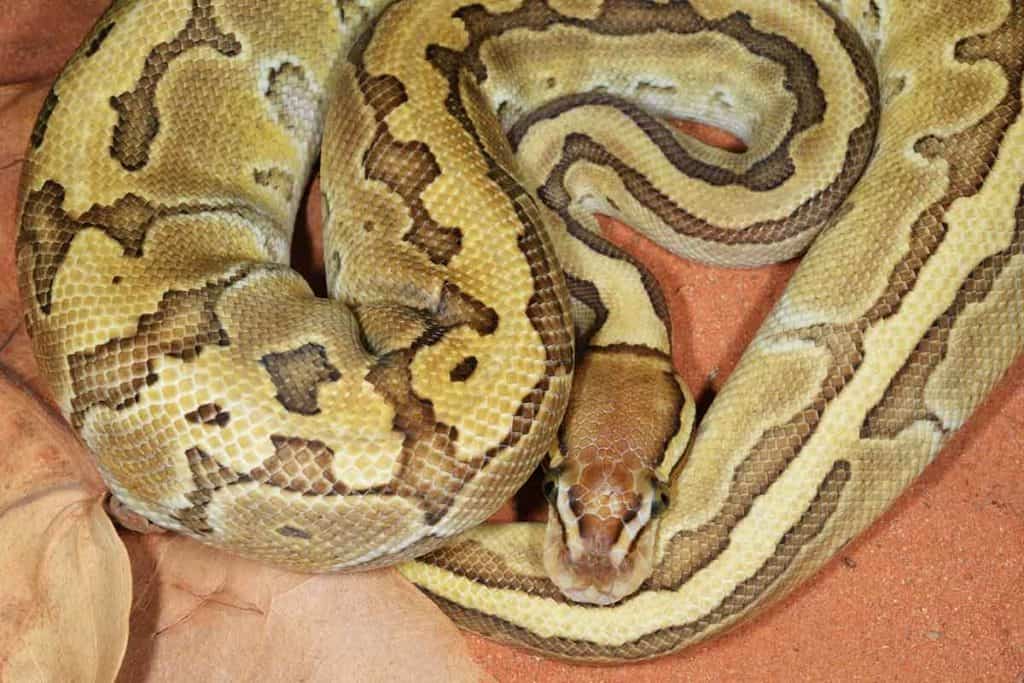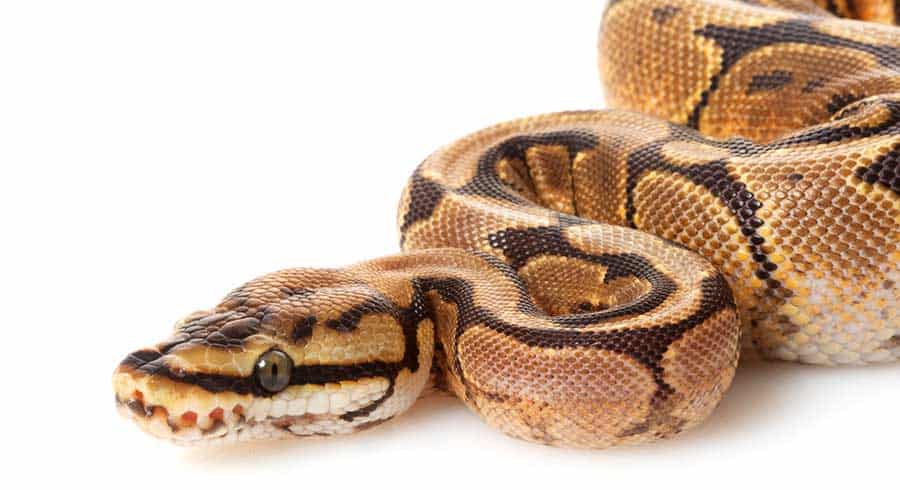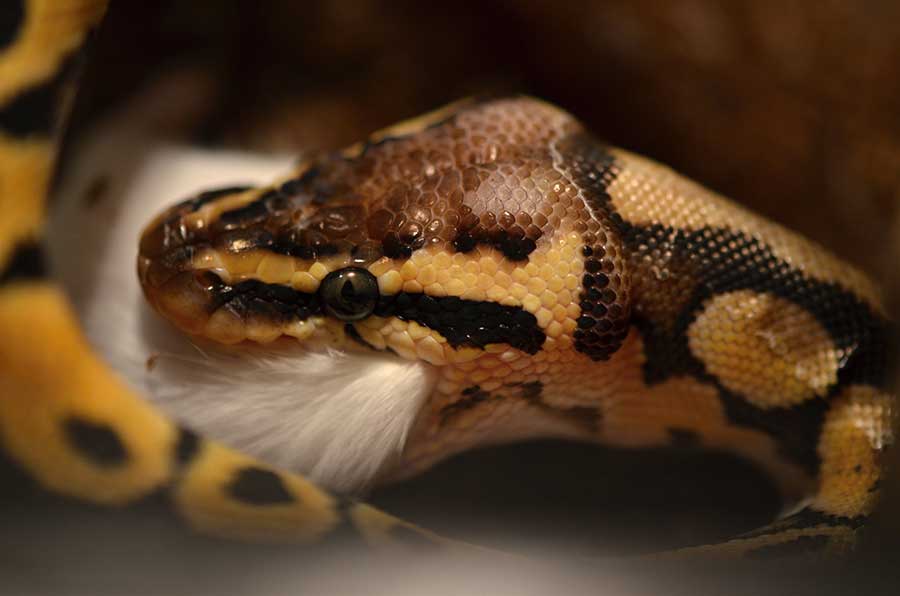Ball pythons are known for being finicky eaters who go on frequent hunger strikes. But how long can a ball python go without eating, anyway?
Snakes in general can go for long stints without food, and ball pythons, also known as royal pythons, are no exception! Everything about ball pythons’ temperaments and care needs makes them the perfect beginner’s snake–except for the fact that they will go on voluntary hungry strikes at the slightest inconvenience, which can be frightening for newbie herpers.
Ball pythons refuse food for many reasons. Some of these reasons can seem silly, like not enjoying the taste of rats and preferring mice, but others can be quite serious, such as having a high intestinal parasite load.
The key is knowing why your ball python has stopped eating. Once you have figured out the root cause of their hunger strike, you can keep a careful eye on their weight and not worry too much, as long as they eventually start eating again and don’t lose too much body fat.
However, if your snake goes a worryingly long time without eating, there are some tricks you can try to get their appetite back up. Read on to find out how long ball pythons can go without food, why they may refuse food, and what you can do about it.
How Long Can a Baby Ball Python Go Without Eating?
Hunger strikes in baby ball pythons are a lot more concerning than hunger strikes in adults. This is because baby ball pythons are growing constantly, and they need lots of fuel in the form of protein!
Baby ball pythons can go a month or two without eating without sustaining serious damage. They will continue to grow, albeit slowly, during this time. After four to six weeks, your baby ball python should take food voluntarily.
If they do not start eating and you have tried all the tricks in the book to get them to eat, then it is time for a trip to the vet. Your vet can give your snake nutrient injections or feed them via a tube down their throat if necessary.
A starving baby ball python may have stunted growth later on in life, so treating the cause of their lack of appetite at this age promptly is crucial to their health.
How Long Can an Adult Ball Python Go Without Food?
With a 30-to-40-year lifespan, you can expect your adult ball python to go on hunger strikes every now and then for various reasons.
Adult ball pythons can go as long as six to seven months without eating any food and not suffer any major damage to their bodies.
Most ball pythons will eventually eat at the six-month mark if they’ve been on a particularly long and strict hunger strike, almost as if their body knows it can’t go much longer without sustaining serious damage.
However, some adult ball pythons will only break their extended fast after a year! This is not the norm, but you should keep an eye on your ball python if they are nearing the 12-month mark without any food. A vet visit during the snake’s fast might be necessary to ensure they aren’t losing too much body fat.
How Do Ball Pythons Survive Starvation Mode?
Ball pythons will not eat for months at a time in the wild due to food scarcity. Their bodies are specially designed to be able to survive these periods without food.
Snakes are also unique creatures in that they can reduce the rate of their own metabolism by up to 70%! They are slow-moving creatures and do not expend a lot of energy in their day-to-day lives.
Therefore, they can reduce their energy output enough to survive the lack of energy coming in when they do not eat.
Ball pythons will know to burn fat reserves for fuel when they are not eating. The danger comes in when they have not eaten for more than seven months and their fat reserves are depleted. When there is no more fat to burn, they will start using protein (muscles and organs) as fuel.
This is why it is essential to keep an eye on how much your snake weighs throughout its life. Check out our guide on ball python growth, size, and weight.
How Often Should I Feed My Ball Python?
Baby and juvenile ball pythons should be fed one prey item the size of their heads once every seven days.
Adult ball pythons should be fed one prey item the size of their heads or smaller (or two or three to get to the correct size) once every 14 days.
Sticking to a schedule can help your ball python build a secure relationship with food and reduce the number of times it will go on a voluntary hunger strike in the future. Keeping track of feedings will also help you control your ball python’s weight and prevent it from becoming obese.
Reasons Your Ball Python Might Refuse Food
There are many reasons why a ball python might refuse to eat, most of which are thankfully minor and easily treatable. Go through the list below and try and identify why your ball python is not eating so you can try to get them back on their normal, healthy schedule as soon as possible.
Temperature Issues
Your ball python may be avoiding food because their enclosure is too cold or too hot. Their enclosure temperature needs to sit within a “Goldilocks zone” and be just right at all times for their metabolism to function properly.
If the temperature is not correct and their metabolism slows down enough, then your ball python will refuse food.
Their enclosure should never drop below 75°F, and their basking spot should sit at around 90°F day and night. You can also use an under-tank heating pad or a ceramic heat emitter to create a comfortable thermal gradient around the clock.
Keep an eye on the temperature with a digital
It’s Shedding Time
Ball pythons will also avoid food if they are shedding. Shedding can be an irritating and uncomfortable ordeal, and most snakes do not want to deal with the added complication of digesting food during the process.
Check out our guide on how often ball pythons shed.
Parasites
You do not feel like eating if you have a tummy bug, and neither does your ball python!
If your ball python has a high intestinal parasite load, then they will not want food. Check their poops for signs of parasite infestation. This may require a trip to the vet to diagnose and treat.
The treatment is a simple round of antiparasitic medication, after which your ball python should start eating again.
It’s Winter
The most common cause of a ball python’s extended fast is a change in season. During the cold, winter months, snakes know they would not be able to be as warm as they need to be to digest food properly, and food would be more scarce. While ball pythons don’t brumate quite as other reptiles do, they usually do experience a period of lower energy and appetite in the winter.
Even though you may keep your ball python’s enclosure at a steady temperature, they will still be able to instinctively tell when it is winter. Every time you open the enclosure to handle your snake or feed them, they can sense what the temperature is like outside.
That is often enough for it to tell if winter has arrived and that it needs to slow its metabolism down, which leads to the snake refusing food in some cases.
How Can I Get My Ball Python to Start Eating Again?
There are a couple of ways to get your ball python to start eating again after an extended period of refusing food. Keep in mind none of them are 100% foolproof, and not all of them will work every time your snake becomes a bit finicky. The efficacy of certain methods below depends largely on your snake’s personality and eating habits.
Warm the Prey Item Up
Your ball python may not be interested in the food because it is not registering as something ‘alive’ and worth eating. Pythons have thermal sensors along their mouths that pick up heat and translate it to information for their brains. Bring the prey item up to body temperature before offering it.
Chop the Prey Item Up
The prey item may be too big for your snake, and they will continue to refuse it. The simple solution is to chop it up into smaller pieces.
Brain/Scent the Prey Item
The prey item may not smell very interesting to your ball python. Try “braining” it once it is defrosted (if you have a strong enough stomach for it!). Simply take a needle or knife and carefully open the skull so that the brain (which apparently smells good to snakes) seeps out. You can also scent the prey item by rubbing it on some fish or other meat.
Wet/Soak the Prey Item
The prey item may be too dry for your snake to be interested in trying to swallow it. Soak your prey item in some broth (not bone or vegetable), and then offer it to your ball python. Soaking it will hydrate it as well as make it smell and taste good!
Balling Up…
Ball pythons are notorious for refusing food and going on voluntary hunger strikes. As their owner, you need to know how long your ball python can go without eating without sustaining damage and what you should do to address their refusal to eat.
It is important to be able to identify why your snake is not taking prey items, as then you can move on to dealing with the problem. Sometimes, it is as simple as waiting for winter to end, and other times, it can mean a trip to the vet and medication.
If you are a ball python owner, then good luck! Ball pythons are finicky when it comes to food, but they are incredibly rewarding pets!




